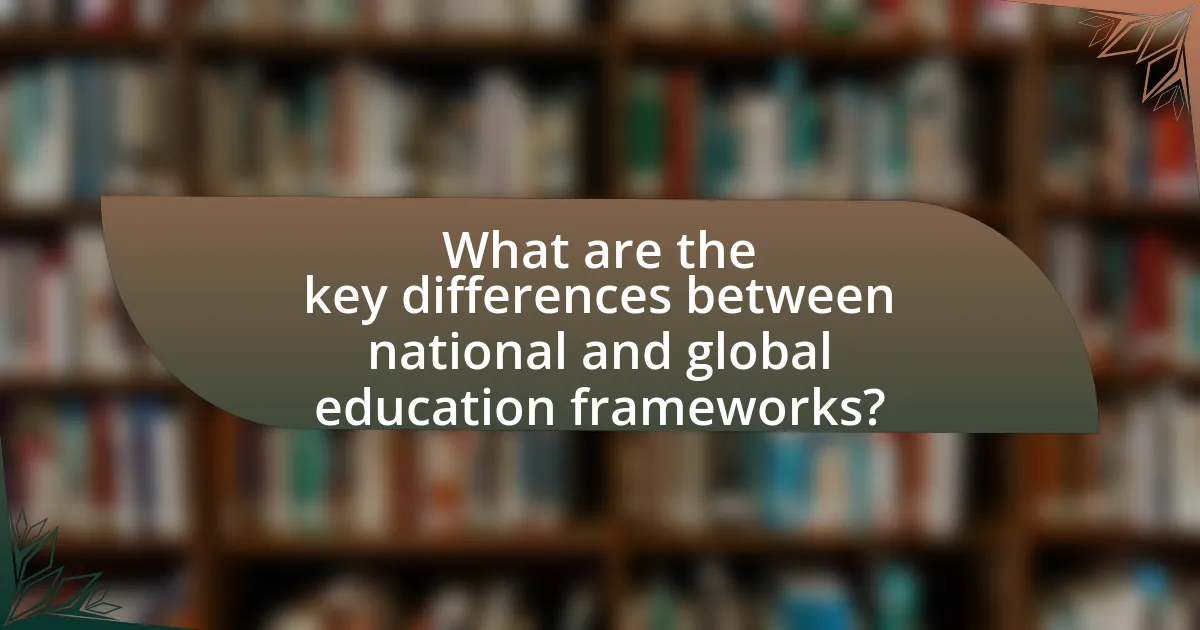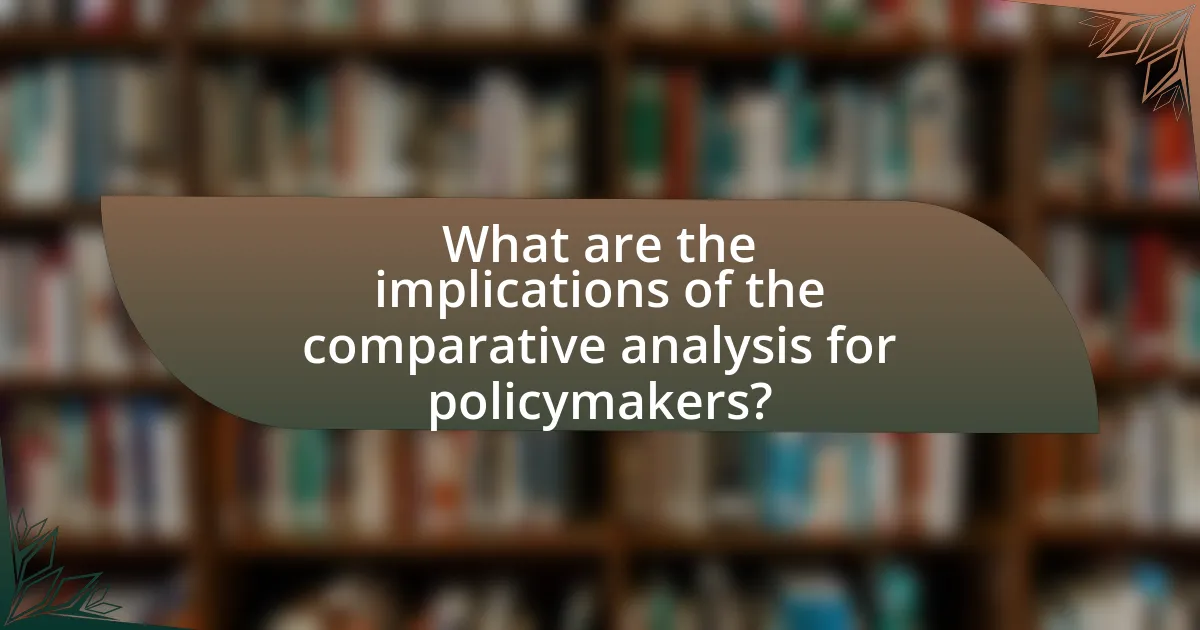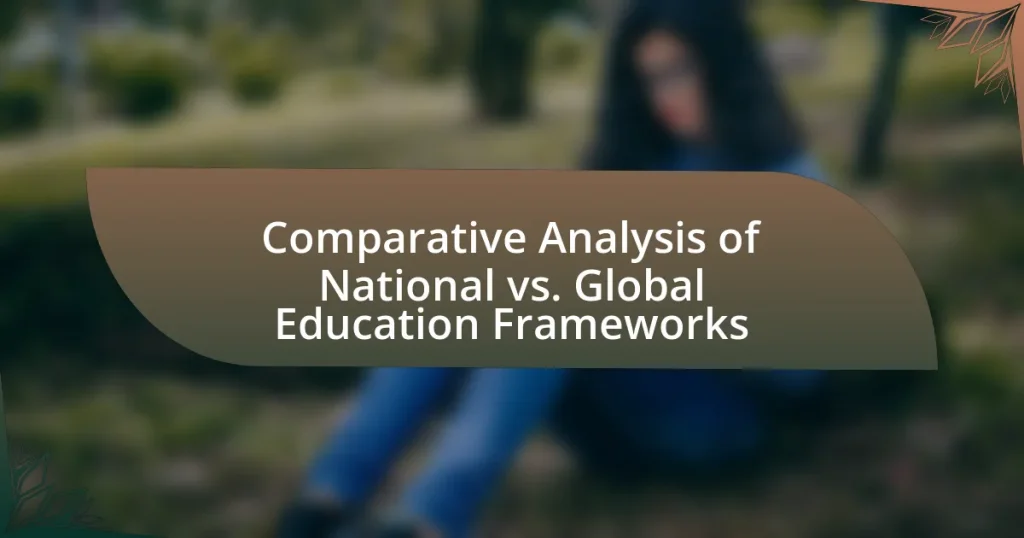The article provides a comparative analysis of national and global education frameworks, highlighting their key differences and implications for educational standards and outcomes. National frameworks are tailored to meet the specific cultural, social, and economic needs of a country, while global frameworks aim for universal educational goals and standards. The discussion includes how these frameworks define educational standards, their primary goals, and the role of global organizations in shaping education policies. Additionally, the article examines the impact of these frameworks on student outcomes, the challenges in comparing them, and the future trends in education that may arise from globalization and technological advancements.

What are the key differences between national and global education frameworks?
National education frameworks are designed to meet the specific needs and contexts of a country’s population, while global education frameworks aim to address universal educational goals and standards across multiple countries. National frameworks often reflect local culture, policies, and economic conditions, such as the U.S. Common Core State Standards, which focus on state-specific educational requirements. In contrast, global frameworks, like the United Nations Sustainable Development Goal 4, emphasize equitable access to quality education worldwide, promoting shared objectives such as literacy and lifelong learning. This distinction highlights that national frameworks prioritize localized educational strategies, whereas global frameworks advocate for a cohesive approach to education that transcends national boundaries.
How do national education frameworks define educational standards?
National education frameworks define educational standards as specific benchmarks that outline the knowledge and skills students are expected to acquire at various stages of their education. These frameworks typically include detailed descriptions of curriculum content, assessment methods, and performance expectations, ensuring consistency and quality across educational institutions. For example, the Common Core State Standards in the United States provide a clear set of expectations for what students should know in mathematics and English language arts, facilitating a uniform educational experience across states.
What are the primary goals of national education frameworks?
The primary goals of national education frameworks are to establish a coherent structure for educational standards, ensure equitable access to quality education, and promote the development of skills necessary for personal and societal growth. National education frameworks aim to align educational objectives with national priorities, thereby fostering a skilled workforce that meets economic demands. For instance, the United Nations Educational, Scientific and Cultural Organization (UNESCO) emphasizes that effective education systems should support lifelong learning and inclusivity, reflecting the need for diverse educational pathways that cater to various learner needs.
How do national frameworks address local cultural and social needs?
National frameworks address local cultural and social needs by incorporating regional values, languages, and community priorities into educational policies and curricula. For instance, many countries develop guidelines that allow for the inclusion of indigenous knowledge and practices, ensuring that education is relevant to diverse cultural backgrounds. This approach is supported by research indicating that culturally responsive education enhances student engagement and achievement, as seen in studies like “Culturally Responsive Teaching: Theory, Research, and Practice” by Geneva Gay, which highlights the positive impact of aligning education with students’ cultural contexts.
What are the characteristics of global education frameworks?
Global education frameworks are characterized by their emphasis on inclusivity, adaptability, and a focus on global citizenship. These frameworks aim to provide equitable access to quality education for all learners, regardless of their geographical location or socio-economic status. They incorporate diverse cultural perspectives and promote critical thinking, collaboration, and problem-solving skills essential for navigating a globalized world. For instance, the United Nations Sustainable Development Goal 4 highlights the importance of ensuring inclusive and equitable quality education and promoting lifelong learning opportunities for all, reinforcing the global commitment to education as a fundamental human right.
How do global education frameworks promote international standards?
Global education frameworks promote international standards by establishing common benchmarks and guidelines that facilitate consistency in educational quality across countries. These frameworks, such as the International Baccalaureate (IB) and the United Nations Educational, Scientific and Cultural Organization (UNESCO) standards, provide a structured approach to curriculum development, assessment, and teacher training. For instance, the IB program emphasizes critical thinking and intercultural understanding, which aligns with global competencies recognized worldwide. By adopting these frameworks, nations can ensure that their educational systems meet internationally accepted criteria, thereby enhancing the mobility of students and the recognition of qualifications across borders.
What role do global organizations play in shaping education frameworks?
Global organizations play a crucial role in shaping education frameworks by establishing international standards and guidelines that influence national education policies. For instance, organizations like UNESCO and the World Bank provide frameworks such as the Education 2030 Agenda, which sets global targets for education quality and access. These frameworks encourage countries to align their educational practices with global benchmarks, promoting equity and inclusivity. Additionally, global organizations often facilitate funding and technical assistance, enabling nations to implement reforms that adhere to these international standards, thereby enhancing the overall quality of education worldwide.

Why is a comparative analysis of national and global education frameworks important?
A comparative analysis of national and global education frameworks is important because it enables policymakers to identify best practices and gaps in educational systems. By examining various frameworks, stakeholders can understand how different countries address similar educational challenges, such as access, quality, and equity. For instance, the Organisation for Economic Co-operation and Development (OECD) provides data through its Programme for International Student Assessment (PISA), which highlights performance differences among countries and informs educational reforms. This analysis fosters collaboration and innovation, ultimately leading to improved educational outcomes on both national and global scales.
How do these frameworks impact student outcomes?
National and global education frameworks significantly impact student outcomes by shaping curriculum standards, assessment methods, and teaching practices. These frameworks influence the quality of education students receive, as evidenced by studies showing that countries adhering to rigorous international benchmarks, such as the Programme for International Student Assessment (PISA), often achieve higher academic performance. For instance, students in countries like Singapore and Finland, which implement comprehensive frameworks, consistently rank at the top in mathematics, reading, and science assessments, demonstrating a direct correlation between structured educational frameworks and improved student achievement.
What evidence exists to support the effectiveness of national versus global frameworks?
Evidence supporting the effectiveness of national versus global frameworks can be found in various studies that highlight their distinct impacts on educational outcomes. National frameworks, such as the Common Core State Standards in the United States, have shown improved student performance in standardized assessments, with a report from the National Assessment of Educational Progress indicating a 10% increase in math scores among fourth graders since its implementation. In contrast, global frameworks like the International Baccalaureate (IB) program have demonstrated success in fostering critical thinking and intercultural understanding, as evidenced by a study published in the Journal of Research in International Education, which found that IB students scored higher on college readiness assessments compared to their peers in national systems. These findings illustrate that while national frameworks can enhance specific academic skills, global frameworks may better prepare students for a diverse and interconnected world.
How do educational outcomes differ across countries with varying frameworks?
Educational outcomes vary significantly across countries with differing educational frameworks due to factors such as curriculum design, assessment methods, and resource allocation. For instance, countries like Finland, which employs a student-centered approach and emphasizes critical thinking, consistently rank high in international assessments like PISA, achieving top scores in reading, mathematics, and science. In contrast, countries with rigid, exam-focused systems, such as China, often prioritize rote memorization, which can lead to high test scores but may not foster deep understanding or creativity. Additionally, the OECD reports that nations with equitable resource distribution, such as Canada, tend to have better educational outcomes compared to those with significant disparities, like the United States, where socioeconomic factors heavily influence student performance.
What challenges arise in comparing national and global education frameworks?
Comparing national and global education frameworks presents challenges such as differing educational standards, cultural contexts, and assessment methods. National frameworks often reflect local values and priorities, which can lead to discrepancies when evaluated against global standards that aim for universality. For instance, the Organisation for Economic Co-operation and Development (OECD) reports that variations in curriculum content and pedagogical approaches can hinder effective comparisons. Additionally, the lack of standardized metrics for measuring educational outcomes across countries complicates the assessment of effectiveness and equity in education systems. These factors create significant barriers to achieving a coherent understanding of educational quality on a global scale.
How do differing educational philosophies affect comparisons?
Differing educational philosophies significantly affect comparisons by shaping the criteria and values used to evaluate educational systems. For instance, a constructivist philosophy emphasizes student-centered learning and critical thinking, leading to comparisons that prioritize innovative teaching methods and student engagement. In contrast, a traditional philosophy focuses on standardized testing and rote memorization, resulting in evaluations that emphasize academic performance metrics. These philosophical differences influence not only the metrics chosen for comparison but also the interpretation of educational outcomes, as seen in the varying approaches to assessments like PISA (Programme for International Student Assessment), which reflects diverse educational priorities across countries.
What are the limitations of current comparative studies?
Current comparative studies face several limitations, including methodological inconsistencies, cultural biases, and data availability issues. Methodological inconsistencies arise when different studies use varying definitions and metrics, making it difficult to draw valid comparisons. Cultural biases can skew results, as educational frameworks are often influenced by local contexts that may not be applicable universally. Additionally, data availability issues hinder comprehensive analysis, as not all countries provide accessible or comparable educational data, leading to gaps in research. These limitations can compromise the reliability and applicability of findings in the comparative analysis of national versus global education frameworks.

What are the implications of the comparative analysis for policymakers?
The implications of the comparative analysis for policymakers include the need to adapt educational strategies that align with both national priorities and global standards. Policymakers must recognize that understanding the strengths and weaknesses of various educational frameworks can inform decisions that enhance educational quality and equity. For instance, countries that have successfully integrated global best practices, such as Finland’s emphasis on teacher training and student well-being, demonstrate improved student outcomes, which policymakers can emulate. Additionally, comparative analysis can reveal gaps in national systems, prompting targeted reforms that address specific deficiencies, such as curriculum relevance or access to technology. This evidence-based approach enables policymakers to make informed decisions that foster a more effective and inclusive education system.
How can insights from this analysis inform educational reforms?
Insights from the comparative analysis of national versus global education frameworks can inform educational reforms by identifying best practices and gaps in current systems. For instance, the analysis may reveal that countries with integrated global competencies in their curricula, such as Finland, show higher student engagement and performance metrics, suggesting that adopting similar approaches could enhance educational outcomes elsewhere. Furthermore, data from the Organisation for Economic Co-operation and Development (OECD) indicates that nations prioritizing collaborative learning and critical thinking skills outperform those focused solely on rote memorization. This evidence supports the need for reforms that emphasize innovative teaching methods and curriculum design aligned with global standards.
What best practices can be adopted from successful frameworks?
Successful frameworks in education emphasize collaboration, adaptability, and evidence-based practices. Collaboration among stakeholders, including educators, policymakers, and communities, fosters a shared vision and enhances the implementation of educational strategies. Adaptability allows frameworks to evolve based on feedback and changing needs, ensuring relevance and effectiveness. Evidence-based practices, supported by research, lead to improved student outcomes and informed decision-making. For instance, the OECD’s PISA assessments highlight the importance of data-driven approaches in shaping educational policies that yield measurable improvements in student performance across various countries.
How can policymakers balance national needs with global standards?
Policymakers can balance national needs with global standards by integrating local educational priorities with internationally recognized benchmarks. This approach involves assessing national educational goals and aligning them with global frameworks, such as the United Nations Sustainable Development Goals for Education, which emphasize quality and inclusivity. For instance, countries like Finland have successfully adapted global educational standards while maintaining their unique cultural context, demonstrating that it is possible to meet both national and international expectations. By fostering collaboration among stakeholders, including educators, government officials, and international organizations, policymakers can create a cohesive strategy that respects local needs while adhering to global standards.
What strategies can be implemented to enhance educational frameworks?
To enhance educational frameworks, integrating technology in teaching and learning processes is essential. This strategy allows for personalized learning experiences, access to a vast array of resources, and the ability to track student progress effectively. For instance, a study by the Bill & Melinda Gates Foundation found that technology-enabled personalized learning can lead to significant improvements in student achievement, particularly in underserved populations. Additionally, fostering collaboration among educators through professional development programs can improve teaching practices and curriculum design, as evidenced by research from the National Education Association, which highlights that collaborative professional development leads to better student outcomes. Implementing these strategies can create a more effective and responsive educational framework.
How can collaboration between nations improve educational outcomes?
Collaboration between nations can improve educational outcomes by facilitating the sharing of best practices, resources, and innovative teaching methods. For instance, international partnerships allow countries to learn from each other’s successes and challenges, leading to the adoption of effective educational strategies. A study by the Organisation for Economic Co-operation and Development (OECD) found that countries participating in collaborative educational initiatives, such as the Programme for International Student Assessment (PISA), showed significant improvements in student performance. This evidence highlights that cross-border cooperation can enhance curriculum development, teacher training, and access to educational technology, ultimately leading to better educational results.
What role does technology play in bridging national and global education frameworks?
Technology serves as a critical facilitator in bridging national and global education frameworks by enabling access to diverse educational resources and fostering collaboration across borders. It allows for the integration of various curricula, making it easier for educators and students to share knowledge and best practices. For instance, platforms like MOOCs (Massive Open Online Courses) provide learners worldwide with access to high-quality educational content, regardless of their geographical location. Additionally, technology supports real-time communication and collaboration through tools such as video conferencing and collaborative software, which enhances cross-cultural exchanges and partnerships. This interconnectedness is evidenced by initiatives like the Global Education Coalition, which leverages technology to ensure inclusive and equitable quality education for all, aligning local educational goals with global standards.
What are the future trends in education frameworks globally?
Future trends in education frameworks globally include increased integration of technology, personalized learning, and a focus on skills development over traditional content knowledge. The rise of online learning platforms and digital resources is reshaping how education is delivered, allowing for more flexible and accessible learning environments. Additionally, personalized learning approaches, which tailor educational experiences to individual student needs, are gaining traction, supported by data analytics and adaptive learning technologies. Furthermore, there is a growing emphasis on equipping students with critical thinking, collaboration, and problem-solving skills, aligning education with the demands of the 21st-century workforce. These trends reflect a shift towards more inclusive, adaptable, and competency-based education systems worldwide.
How might globalization influence national education policies?
Globalization influences national education policies by promoting the adoption of international standards and practices. As countries engage in global economic and cultural exchanges, they often align their educational frameworks with those of other nations to enhance competitiveness and meet global labor market demands. For instance, the OECD’s Programme for International Student Assessment (PISA) has led many countries to reform their education systems to improve student performance in reading, mathematics, and science, reflecting a shift towards standardized assessments that facilitate international comparisons. This alignment can result in curriculum changes, increased emphasis on STEM education, and the incorporation of technology in classrooms, all aimed at preparing students for a globalized workforce.
What emerging challenges should be addressed in future frameworks?
Emerging challenges that should be addressed in future education frameworks include the integration of technology in learning environments, the need for equitable access to educational resources, and the adaptation to diverse learning needs. The rapid advancement of technology necessitates frameworks that incorporate digital literacy and online learning methodologies, as evidenced by the increased reliance on remote education during the COVID-19 pandemic. Additionally, disparities in access to quality education highlight the importance of addressing socioeconomic barriers, with UNESCO reporting that 258 million children and youth were out of school in 2018, emphasizing the need for inclusive policies. Furthermore, the recognition of varied learning styles and disabilities calls for frameworks that support personalized education, as research indicates that differentiated instruction can significantly enhance student engagement and achievement.
